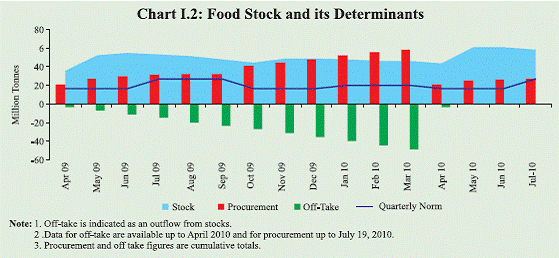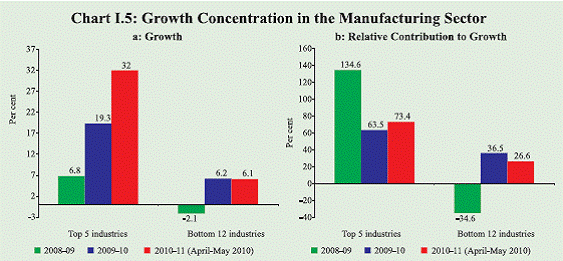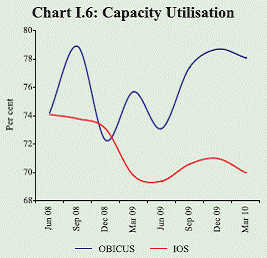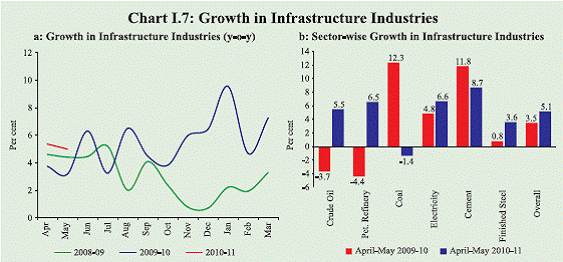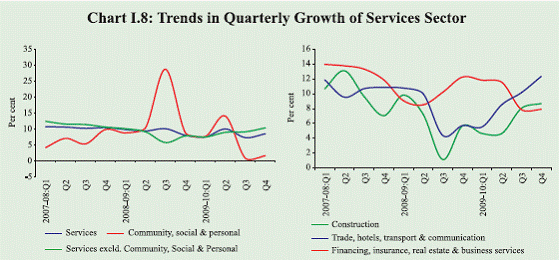 IST,
IST,
I. Output
The Indian economy exhibited robust acceleration in the pace of recovery in the fourth quarter of 2009-10, led by strong double digit growth in industrial activities. Contrary to earlier concerns about the adverse impact of the deficient monsoon, the agricultural output showed modest positive growth. Services activities, which had remained resilient throughout the phase of slowdown, showed further pick-up in momentum. Excluding the“ community, social and personal services” segment, growth in services sector in the fourth quarter of 2009-10 reached closer to the pre-global crisis trend. The IIP has continued to grow at a robust pace in 2010-11 so far, notwithstanding some moderation in May 2010. Lead indicators for services sector also suggest continuation of the robust trend. Capacity utilisation rate remained high and employment growth was positive unlike the jobless recovery seen in advanced economies. Overall GDP growth in 2010-11 could be expected to accelerate further to get closer to its trend rate. I.1 The real GDP growth for 2009-10 was revised upwards to 7.4 per cent from the earlier estimate of 7.2 per cent, mainly on account of strong growth of 8.6 per cent in the fourth quarter as well as upward revision in growth figures for earlier quarters (Table I.1). In Q4 of 2008-09, the pace of deceleration in growth was the maximum. The acceleration in Q4 of 2009-10 resulted despite weak agriculture sector performance as well as tapering off of the stimulus measures’ impact on the “community, social and personal services” sector.
Agricultural Situation I.2 Rainfall during the South-West monsoon season of 2010 (June to September) is likely to be 102 per cent of the long period average (LPA) (with a model error of ± 4.0 per cent) as per the revised forecasts dated June 25, 2010 by the India Meteorological Department. The cumulative area weighted rainfall during the season so far (up to July 21, 2010) has been 14 per cent below LPA as against 19 per cent below LPA during the corresponding period of the previous year. Of the 36 meteorological subdivisions, cumulative rainfall was excess/normal in 26 sub-divisions (21 sub-divisions last year) (Chart I.1). As on July 22, 2010, the total live water storage in 81 major reservoirs of the country was 19 per cent of the Full Reservoir Level (24 per cent during the corresponding period last year). I.3 Available data show that the area sown during kharif 2010 (as on July 22) was higher than in the corresponding period of the previous year for all crop categories. The area coverage was, however, lower in a few individual crops such as urad, jowar, maize and soyabean, mainly due to deficient monsoon in the respective crop growing states of Rajasthan and Madhya Pradesh (Table I.2).
I.4 The Fourth Advance Estimates for agricultural production in 2009-10 placed the foodgrains output at 218.2 million tonnes, a decline of 6.9 per cent over the preceding year. Food Management I.5 The total stock of foodgrains with the Food Corporation of India (FCI) and other government agencies, increased to 58.4 million tonnes as on July 1, 2010 (Chart I.2). Since food price inflation has remained high despite rising stock of foodgrains much above the buffer norms, the policy on food management has to focus on better supply management in relation to demand besides addressing the structural capacity constraints in food items. Industrial Performance I.6 The industrial sector has maintained double digit growth since August 2009 (except September 2009) (Chart I.3). Increasingly manufacturing growth is being led by capital goods industries and consumer durables (Chart I.4a, b and Table I.3). The pick-up in capital goods production was mainly on account of acceleration in segments like “machinery and equipment other than transport equipment”, “metal products and parts” and “transport equipment”. Although industrial output decelerated marginally in the month of May 2010 as compared to 15 per cent growth recorded during Q4:2009-10, the pace of the increase is still robust. Notwithstanding the impact of the base effect and possible weakness in global demand which may cause some moderation in the pace of growth, industrial activities could be expected to remain buoyant. I.7 The manufacturing sector growth is getting more broad-based. Five top manufacturing industries, with a combined weight of 24.6 per cent in IIP, grew at 19.3 per cent, contributing about 63.5 per cent of the total growth during 2009-10 as compared with 134.6 per cent in the previous year. However, during April-May 2010, top five manufacturing industries with a combined weight of 24.6 per cent in IIP, grew at 32 per cent, contributing 73.4 per cent. (Chart I.5). I.8 During the period April 2009- February 2010, capacity utilisation levels in the infrastructure sector showed a mixed trend. While finished steel and fertiliser sectors recorded higher utilisation as compared with the same period last year, cement and refinery production of petroleum sector witnessed lower utilisation for the same period (Table 1.4). The Order Books, Inventories and Capacity Utilisation Survey (OBICUS) of the Reserve Bank indicates that capacity utilisation, which was witnessing an improvement since Q2 of 2009-10, declined marginally in Q4 of 2009-10. The Industrial Outlook Survey (IOS) of the Reserve Bank also points to a similar pattern (Chart I.6). A part of the moderation in capacity utilisation could have resulted from the augmentation of capacity driven by the sharp acceleration in investment growth in the fourth quarter of 2009-10. Capacity utilisation rates, however, appear to be stretched in areas like import cargo and domestic passenger segment of the aviation sector.
I.9 The government has been monitoring the impact of the global crisis on employment through quarterly surveys. Even though a decline was observed during the first quarter of 2009-10, the employment situation improved in the next two quarters and showed a marginal rise in the last quarter of 2009-10 (Table I.5).
Infrastructure I.10 The six core industries registered a growth of 5.1 per cent during April-May 2010-11 as against 3.5 per cent during the same period in 2009-10 (Chart I.7a and b). The growth in the infrastructure sector during the year so far has come largely from electricity, steel, crude and petroleum refinery sectors while the growth in cement production was subdued and that of coal production was negative. In recent months, the pace of infrastructure growth has lagged behind the pace of industrial growth, which will further widen the infrastructure gap. I.11 Natural gas production, which is not reflected in the core infrastructure index, increased sharply during 2009-10 on account of commencement of production from the D6 block in Krishna-Godavari (KG) basin and Rajasthan fields (Cairn). Natural gas production witnessed a sharp growth of 44.8 per cent in 2009-10 as compared with 1.4 per cent in 2008-09. Gas production increased by 43.5 per cent in April-May 2010 as compared with 11.7 per cent in the same period last year. Services Sector I.12 The services sector rebounded in Q4:2009-10 after some moderation in the previous quarter (Chart I.8). While the growth in the segment related to manufacturing viz., ‘construction’ and “trade, hotel, transports and communication” accelerated, the “financing, insurance, real estate and business services” segment remained steady. Excluding “community, social and personal services”, services sector reached closer to the growth trajectory that was achieved prior to the global crisis. I.13 Data on a number of lead indicators of services sector activities like tourist arrivals, commercial vehicles production and railway freight traffic suggest continuation of the buoyancy in 2010-11 (Table I.6). I.14 To sum up, GDP growth in the last quarter of 2009-10 was higher than previously expected, and going by the lead indicators, this growth rate seems sustainable. On the supply side, the agriculture and allied sector is expected to post a better performance than last year. Continuing resilience of the services sector, coupled with buoyancy of the industrial sector would lend further support to this growth momentum. Demand side factors like revival of private consumption demand and pick-up in private investment are expected to offset the slowdown in government consumption due to the gradual exit from the fiscal stimulus measures. I.15 While the pick-up in investment is already significant, going forward, the sustainability of current buoyancy in industrial and services growth would require large additions to capacity. The possibility of crowding-out pressures has reduced after the better than expected collections through 3G/BWA spectrum auctions. However, risks to growth could arise from inflation and uncertainties on the external front.
|
||||||||||||||||||||||||||||||||||||||||||||||||||||||||||||||||||||||||||||||||||||||||||||||||||||||||||||||||||||||||||||||||||||||||||||||||||||||||||||||||||||||||||||||||||||||||||||||||||||||||||||||||||||||||||||||||||||||||||||||||||||||||||||||||||||||||||||||||||||||||||||||||||||||||||||||||||||||||||||||||||||||||||||||||||||||||||||||||||||||||||||||||||||||||||||||||||||||||||||||||||||||||||||||||||||||||||||||||||||||||||||||||||||||||||||||||||||||||||||||||||||||||||||||||||||||||||||||||||||||||||||||||||||||||||||||||||||||||||||||||||||||||||||||||||||||||||||||||||||||||||||||||||
पृष्ठ अंतिम बार अपडेट किया गया:







